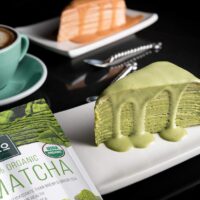Original Post from kblog.lunchboxbunch.com
1. High Quality Matcha.
I am a matcha snob. But that doesn’t mean that I always spend $50/30g canisters and that I flick my wrist to matcha that is not perfect. No, not that kind of snob. I just know the difference between a high quality matcha and a low quality matcha. And when I make matcha at home, I have the power and knowledge to make it the best latte possible. And quality matters. High quality matcha matters not for snobbery sake but for a few very important reasons:
– taste. High quality matcha tastes better. Sweet and grassy with a slightly nutty, very mildly earthy flavor. Lower quality matcha has a much stronger earthy flavor, and the grassiness is muddled, bitter and unappealing.
– color. high quality matcha is bright spring green in color. The makes your matcha look prettier and also most likely means that more of those precious green tea antioxidants, also known as catechins, are in tact.
– origin. High quality matcha means that origin is accounted for. I only drink matcha from Japan.
– organic. I also only drink organic matcha, when possible. I am a fan of organic farming both for quality sake and also environmental factors.
2. Non-Dairy Milk.
I only make matcha lattes that are non-dairy. Not only because I am vegan and enjoy drinking “milk” that is lactose-free and cruelty-free, but also because there has been some research done that says matcha and dairy milk just do not mix well. Dairy milk may actually interfere with absorption of green tea antioxidants..
“German researchers found that casein found in dairy milk binds to the delicate catechins in green tea, inhibiting the absorption. This means that you may want to skip the dairy milk in your matcha recipes and instead use soy, almond or rice milks, which are casein free.” – More info at Dr Weil’s website
Choose a non-dairy milk that tastes good to you. I enjoy homemade almond and organic/non-GMO soy milk best. Soy milk allows for more foam, most of the time, which I do admit I adore.
3. Sweeten Naturally.
Adding sweetener to taste is important. Sometimes I add zero sweetener and want to really enjoy the complex flavors of the matcha. Other times I like lots of sweetener to make my matcha latte taste like a treat! I still say that sweet matcha lattes with lots of foam taste like marshmallows. No, seriously.
Some vegan sweetener options:
– maple syrup
– agave syrup
– organic sugar
– medjool dates
4. Blend it Up!
Though matcha is traditionally made with a bamboo whisk, I have to say that I go against tradition (most times) and use my Vitamix to blend my matcha lattes. This produces a lovely airy, foamy texture to the latte. However, I have seen some matcha whisking pros, get significant amounts of air into the matcha using the proper tools: bamboo whisk and a wide matcha bowl.
5. Maximize Heat
There is nothing worse than lukewarm coffee. Well, for me, the same goes for matcha. For my matcha lattes I like to optimize the heat without over-heating and destroying the flavor and raw nature of the matcha. I usually blend my matcha with very hot water and then add super hot, preheated non-dairy milk once the matcha has dissolved into the water. I highly advise against “re-heating” your matcha latte in a microwave. Not because i think microwaves are bad, I actually do not, but because it over cooks the matcha and the taste can sour into bitterness. (Microwaves apply such strong heat that is not good for the matcha taste and quality, from my experience.) Use your stove for the best matcha latte ever.
6. Add Mint or Vanilla for a Twist!
I love adding natural extracts and flavors to my lattes! Try a real vanilla bean (scoop those seeds!) for the best vanilla-matcha latte ever. And use real mint or peppermint extract for a minty flavor. I am totally into adding mint to all my matcha recipes lately. I am even in the process of making my own peppermint extract! The recipe involves vodka + fresh mint + a few months of aging! I cannot wait to see how it turns out.
7. Serving Vessel
Everyone needs a sparkly, happy, soulful matcha bowl, mug or cup. Seriously. Matcha lattes served in happy mugs taste so much better! I love this black cup from Japan, I bought it in a tiny import store in Venice. I also love my giant Disneyland mug for my extra large matcha lattes.

Published 06/05/2015 | Yield: 1 latte | Total time: 5 mins
Ingredients
- 3/4 cup non-dairy milk (soy or almond are my preference)
- 1/2 cup water (for a creamier latte, you may use more or 100% non-dairy milk as the liquid)
- 2 tsp enzo organic matcha green tea
- 1-3 drops peppermint extract
- sweeten to taste with maple syrup, organic sugar, agave or blended Medjool dates
Instructions
- Bring water to a slow boil in a small sauce pot. Add water to blender. Turn blender on low and add in the matcha while blender is blending.
- Warm non-dairy milk to just under boiling, in same sauce pot. Note: Microwave can be used as well for faster heating of water and milk – just do not place green tea in the microwave)
- Pour the warmed non-dairy milk into the blender. Add mint and sweetener as well. Blend for a few minutes for whip air into the latte and help foam form.
- Pour blended liquid into serving mug or cup or glass. Drink while warm, frothy and steamy. I like to add a drizzle of sweetener right on top of the foam just before serving.
- Sweetener note: start with a teaspoon of sweetener.







